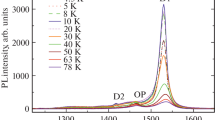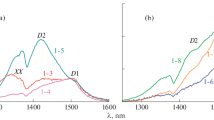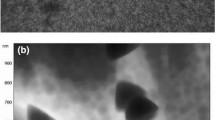Abstract
Multiple implantation of oxygen ions with energies of 0.1–1.5 MeV at doses of 7 × 1013−2 × 1014 cm−2 and subsequent annealing in a chlorine-containing atmosphere at 900°C for 4 h give rise to dislocation-related luminescence in p-Si. A p → n conductivity-type conversion is also observed in this case in the surface layer of Si, which indicates that electrically active donor centers are formed in the process. Preliminary heat treatment of wafers covered with an erbium-doped film of tetraethoxysilane (TEOS) in argon at 1250°C for 1 h does not preclude the appearance of dislocation-related luminescence, but affects the parameters of the dislocation-related lines (peak positions and intensities).
Similar content being viewed by others
References
M. A. Green, J. Zhao, A. Wang, et al., Nature 412, 805 (2001).
A. M. Emel’yanov, V. V. Zabrodskiĭ, N. V. Zabrodskaya, et al., Fiz. Tekh. Poluprovodn. (St. Petersburg) 40, 882 (2006) [Semiconductors 40, 860 (2006)].
V. Kveder, V. Badylevich, E. Steinman, et al., Appl. Phys. Lett. 84, 2106 (2004).
E. O. Sveinbjornsson and J. Weber, Appl. Phys. Lett. 69, 2686 (1996).
S. Binetti, M. Donghi, S. Pizzini, et al., Solid State Phenom. 57–58, 197 (1997).
N. A. Sobolev, A. M. Emel’yanov, E. I. Shek, et al., Phys. Status Solidi C 2, 1842 (2005).
S. Pizzini, E. Leonti, S. Binetti, et al., Solid State Phenom. 95–96, 273 (2004).
N. A. Sobolev, M. S. Bresler, O. B. Gusev, et al., Fiz. Tekh. Poluprovodn. (St. Petersburg) 28, 1995 (1994) [Semiconductors 28, 1100 (1994)].
T. Gregorkiewicz, I. Tsimperidis, C. A. J. Ammerlaan, et al., Mater. Res. Soc. Symp. Proc. 422, 207 (1996).
N. A. Sobolev, O. B. Gusev, E. I. Shek, et al., Appl. Phys. Lett. 72, 3326 (1998).
N. A. Sobolev, O. B. Gusev, E. I. Shek, et al., J. Lumin. 80, 357 (1999).
N. A. Sobolev, A. M. Emel’yanov, E. I. Shek, et al., J. Phys.: Condens. Matter 14, 13241 (2002).
N. A. Sobolev, A. M. Emel’yanov, E. I. Shek, et al., Mater. Sci. Eng. B 91–92, 167 (2002).
A. M. Emel’yanov and E. I. Shek, Fiz. Tverd. Tela (St. Petersburg) 46, 1751 (2004) [Phys. Solid State 46, 1810 (2004)].
N. A. Sobolev, A. M. Emel’yanov, V. V. Zabrodskiĭ, et al., in Abstracts of III Russian Meeting on Growth of Silicon Crystals and Films and Studies of Their Physical Properties and Structural Perfection (Krasnoyarsk, 2006), p. 82.
N. A. Sobolev, O. V. Alexandrov, V. V. Emtsev, et al., Solid State Phenom. 47–48, 299 (1995).
D. Z. Nazyrov, G. S. Kulikov, and R. Sh. Malkovich, Fiz. Tekh. Poluprovodn. (Leningrad) 25, 1653 (1991) [Sov. Phys. Semicond. 25, 997 (1991)].
V. V. Emtsev, V. V. Emtsev, Jr., D. S. Poloskin, et al., Fiz. Tekh. Poluprovodn. (St. Petersburg) 33, 649 (1999) [Semiconductors 33, 603 (1999)].
Author information
Authors and Affiliations
Additional information
Original Russian Text © N.A. Sobolev, B.Ya. Ber, A.M. Emel’yanov, A.P. Kovarskiĭ, E.I. Shek, 2007, published in Fizika i Tekhnika Poluprovodnikov, 2007, Vol. 41, No. 3, pp. 295–297.
Rights and permissions
About this article
Cite this article
Sobolev, N.A., Ber, B.Y., Emel’yanov, A.M. et al. Dislocation-related luminescence in silicon, caused by implantation of oxygen ions and subsequent annealing. Semiconductors 41, 285–287 (2007). https://doi.org/10.1134/S1063782607030086
Received:
Accepted:
Issue Date:
DOI: https://doi.org/10.1134/S1063782607030086




